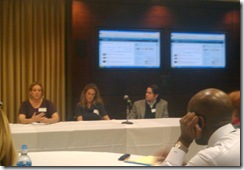 This past Wednesday, we attended another excellent event organized by the Social Media Club DC (SMCDC), about the state of social media use in elections. As a topic that The Bivings Report has touched upon many times in the past several months, we were excited to hear the perspectives of political operatives, academics and non-profit consultants as to the best practices and tactics of the 2010 midterm elections. Lobbyists, PR professionals, and social media entrepreneurs were all eager to analyze the impact and results that Twitter, Facebook, and Foursquare had on voter turnout and results.
This past Wednesday, we attended another excellent event organized by the Social Media Club DC (SMCDC), about the state of social media use in elections. As a topic that The Bivings Report has touched upon many times in the past several months, we were excited to hear the perspectives of political operatives, academics and non-profit consultants as to the best practices and tactics of the 2010 midterm elections. Lobbyists, PR professionals, and social media entrepreneurs were all eager to analyze the impact and results that Twitter, Facebook, and Foursquare had on voter turnout and results.
Professor Lauren Feldman of American University shared her analysis of the polling data her team obtained during the Jon Stewart/Stephen Colbert’s Rally to Restore Sanity and/or Fear. The rally offered special badges on Foursquare just for checking in, and Feldman shared statistics about what parentages of people used social media to learn about the event and its details. For instance, of the 232,122 people who RSVP’d on Facebook, it appears that nearly everyone showed up. Also worth noting- while 31% of survey respondents at the rally reported directly volunteering for a political cause at some point in the past year, twice as many- 64% used social media as a form of political participation.
As for the role of location based tools and during the election, while 12 million Facebook users clicked the “I Voted” button, only 56,000 Foursquare users got the voting badge. Also for those of you wondering why custom Foursquare badges are few and far between, one attendee with insider knowledge claimed that Foursquare asks for $100,000 and 6-month timeframe to get a custom badge created.
The event speakers included:Katie Harbath, Chief Digital Strategist at the National Republican Senatorial Committee, Lauren Feldman, a faculty member at American University in political science and Michael Mayernick, founder of social giving startup giv.to. A few interesting highlights from the panelists included:
Moving forward, the Q&A session also brought up some interesting social media policy questions, such as whether or not it is appropriate for elected officials who leave office to keep their official titles in their Twitter handles and if official accounts such as @PressSec created by Robert Gibbs belong to him or the government. The consensus was that for accounts like @GovMikeHuckabee, keeping the “Gov” title is acceptable as a matter of protocol, but that @PressSec belongs to the office of the @WhiteHouse Press Secretary, not an individual person.
Sign up today to have our latest posts delivered straight to your inbox.